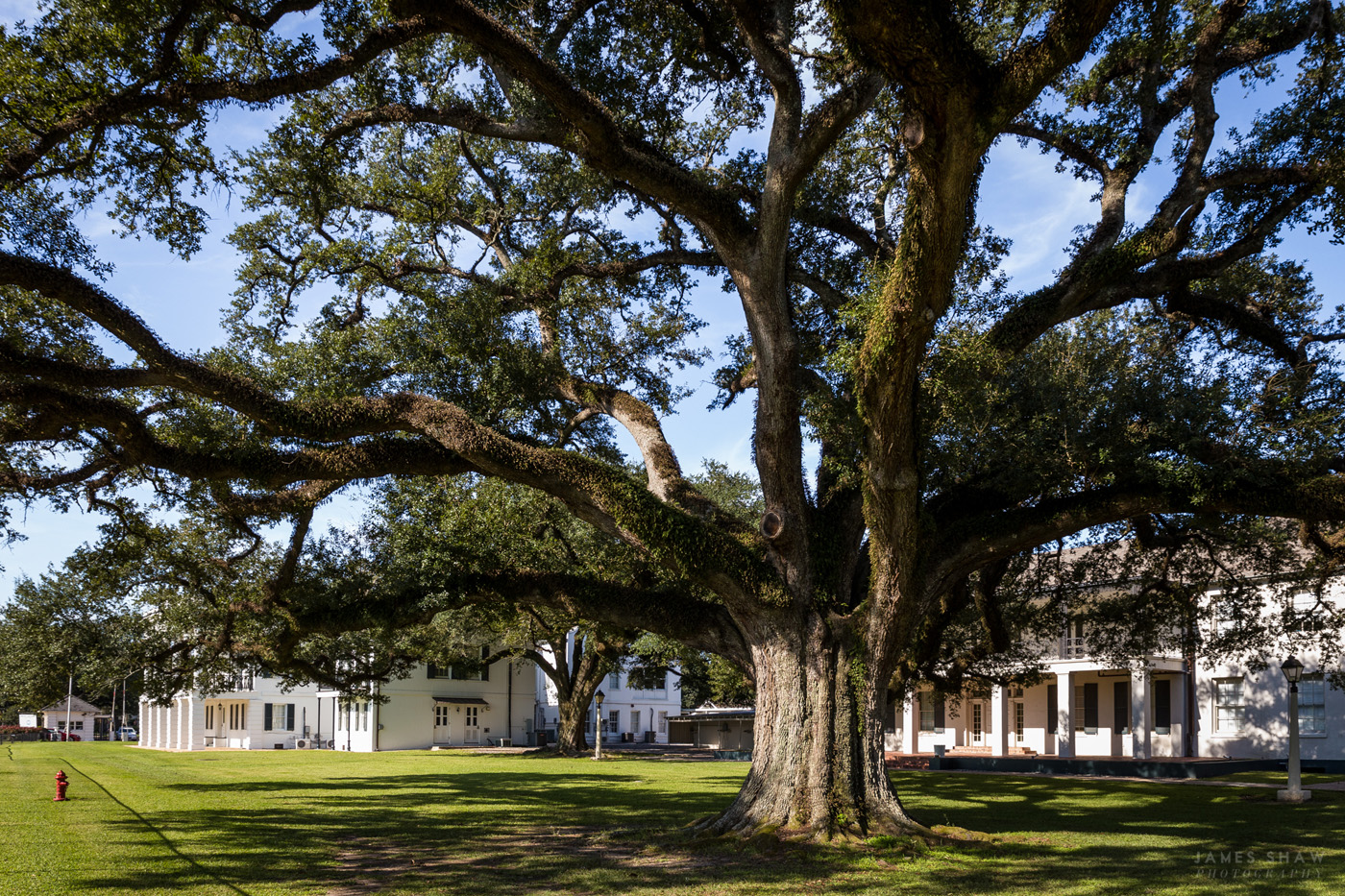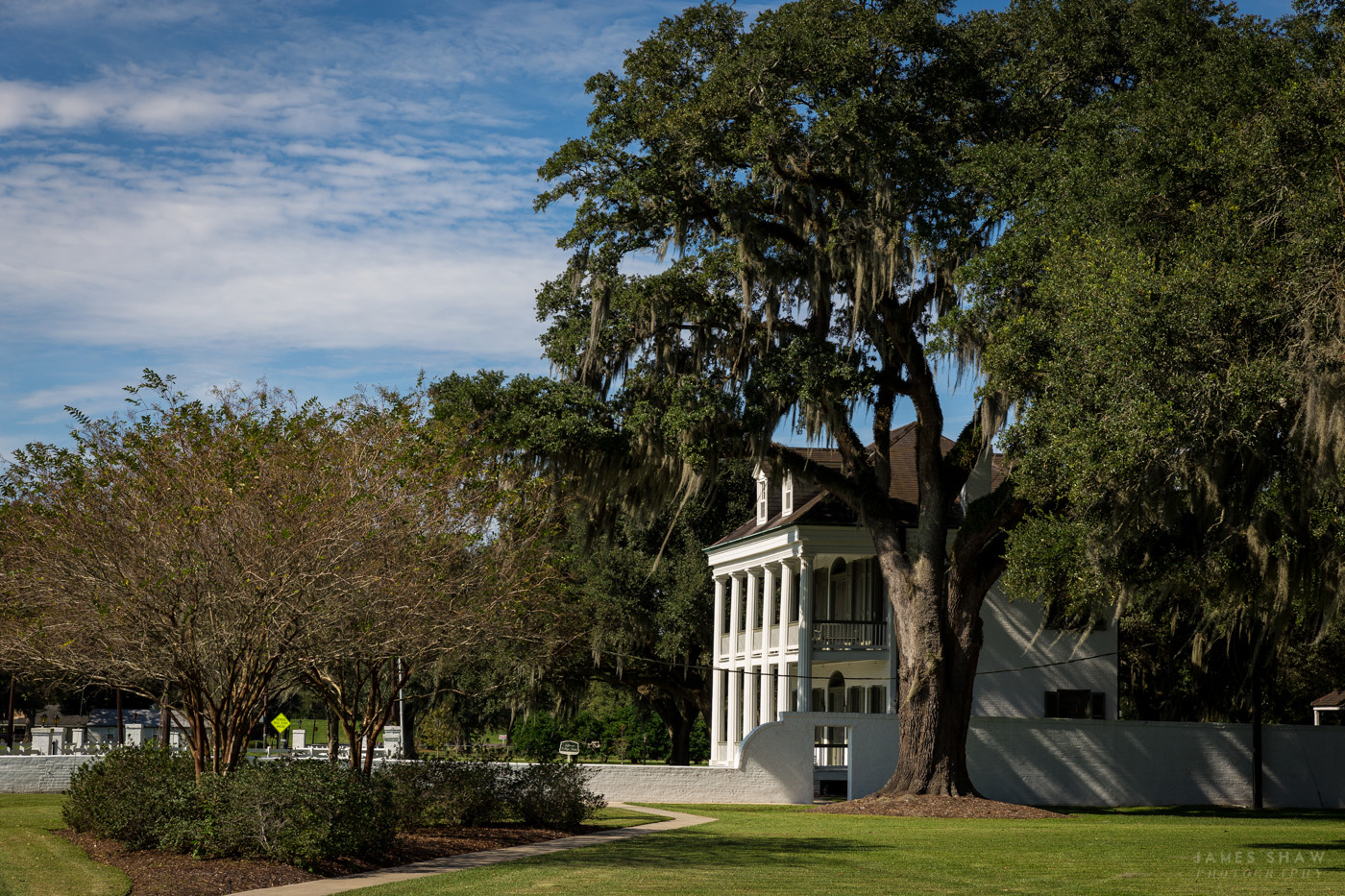I spent half a day last month on a trip down River Road to photograph some massive oaks for Bayou Tree's upcoming calendar. I was surprised to find out what lay just down the road.
Our journey down River Road would start at a very mysterious and very misunderstood complex located on an isolated bend in the Mississippi River. This 300 acre compound has quite the history. Once a thriving plantation, it was left abandoned after the Civil War. After years of rot and decay it was turned into the largest medical quarantine hospital in the world. This facility was instrumental in finding a cure and ending one of humanity's most devastating illnesses...Leprosy, now known as Hansen's Disease.
Our journey down River Road would start at a very mysterious and very misunderstood complex located on an isolated bend in the Mississippi River. This 300 acre compound has quite the history. Once a thriving plantation, it was left abandoned after the Civil War. After years of rot and decay it was turned into the largest medical quarantine hospital in the world. This facility was instrumental in finding a cure and ending one of humanity's most devastating illnesses...Leprosy, now known as Hansen's Disease.
"To say that Carville is just a place about Hansen's disease is like
saying that Moby Dick is just a tale about a whale."
-James Carville, 1994
The last time most American's heard the word Leprosy was probably in Sunday school. If you polled most people about the disease today, they'd probably tell you it doesn't exist anymore. And while they're mostly right, it still does...even here in America. Twenty million people worldwide still suffer from the disease, and about 150 people are still diagnosed in the U.S. every year. If caught early enough it is totally treatable, but it wasn't always that way. Up until the 1960's if you were diagnosed with Hansen's Disease you were forcibly quarantined at one place- Carville, Louisiana.
Carville was the sight of the one and only Leper colony to ever exist in the continental U.S. The history of Carville is fascinating, and yet most people have never even heard of it. It's especially fascinating when you live less than an hour away.
Carville was the sight of the one and only Leper colony to ever exist in the continental U.S. The history of Carville is fascinating, and yet most people have never even heard of it. It's especially fascinating when you live less than an hour away.
Indian Camp Plantation prior to the restoration
Because of the port and the thousands of people arriving daily from all over the world, New Orleans was ground zero for leprosy in the United States in the 1800's. At the time, no one understood the disease, much less how you got it, and naturally it scared the population at large. Something had to be done. So in 1894 the state of Louisiana turned an abandoned sugar plantation on an isolated bend in the Mississippi into the country's first Leper colony.
Throughout history Leprosy was a nasty, heinous, completely misunderstood disease. Contrary to popular belief, one's fingers and toes do not fall off, they are simply reabsorbed by the body. It is a cruel disease, but perhaps the cruelest part is that it doesn't kill you. You have to live the rest of your days as an outcast. There's nowhere to hide, and people can be very, very mean. Of course, in the Bible it was literally a curse from God, so naturally if you were a leper you deserved it. You think religious zealots are bad today? Imagine what they were capable of back then. It wasn't just embarrassing to have Hansen's disease, it was downright dangerous...for both you and your family.
Throughout history Leprosy was a nasty, heinous, completely misunderstood disease. Contrary to popular belief, one's fingers and toes do not fall off, they are simply reabsorbed by the body. It is a cruel disease, but perhaps the cruelest part is that it doesn't kill you. You have to live the rest of your days as an outcast. There's nowhere to hide, and people can be very, very mean. Of course, in the Bible it was literally a curse from God, so naturally if you were a leper you deserved it. You think religious zealots are bad today? Imagine what they were capable of back then. It wasn't just embarrassing to have Hansen's disease, it was downright dangerous...for both you and your family.
The first order of business upon your arrival to Carville was to change your legal name, for the safety of your family of course. You left everything behind. Everything. Your life as you knew it was over. There was no treatment, and of course, no cure. Like it or not, you were going to die here. Just try to imagine that for one second.
The first seven patients were admitted on December 1, 1894. The original staff consisted of four Daughters of Charity, bless their souls. In a time when people thought of it as a highly contagious disease, these sisters and doctors were treating patients on a daily basis...mainly to just make sure they were comfortable. Talk about doing God's work. In 1921, with the patient population swelling to over 400, the U.S. Public Health service took over and devoted much more money and research into finding a cure.
In the 1940's staff doctor Guy Faget from New Orleans found that cure, largely putting an end to a disease that had been around since the dawn of time. It was simply known as the Miracle at Carville. Luckily, Hansen's disease never became an epidemic in Louisiana or anywhere else in America, and no doctors or nurses ever contracted the disease. Only recently have researchers discovered that about 95% of the world's population is naturally immune to the bacteria that causes the disease.
But the tale at Carville is not entirely a sad one. Despite the reputation and stigma of Leprosy, Carville became a haven for the poor souls suffering from the disease. People found refuge here. They had jobs here, lived in a beautiful community, and most importantly, were treated with dignity and respect...something the outside world would never offer them again. It was a new beginning.
Although Carville was sealed off from the rest of the world, it was a self sufficient community, and for some patients brought here as children, it was all they knew. Even after a cure was found, many people decided to live out their remaining years at Carville. Patients got married and had kids, living on the beautiful grounds in their own houses. They had their own power plant, churches, theater, golf course, stocked lake, and even a magazine. Patients looked forward to the annual Mardi Gras all year long. Carville offered a great life to its patients.
And although many of them never saw their families again, by all accounts they were genuinely loved by those who cared for them. It wasn't perfect, but it was better than what the outside world had to offer.
By the 1990's Carville's population had dwindled down to around 130. The hospital would close its doors for good in 1999, allowing the last few patients the options of finishing out their lives at Carville. According to a kind lady who worked there, the last patient left (or died) about 7 months ago. For someone that had been shunned by their own family and society at large, this place must have been a paradise. At least that's the impression I got after listening to interviews of some of the former patients.
By the 1990's Carville's population had dwindled down to around 130. The hospital would close its doors for good in 1999, allowing the last few patients the options of finishing out their lives at Carville. According to a kind lady who worked there, the last patient left (or died) about 7 months ago. For someone that had been shunned by their own family and society at large, this place must have been a paradise. At least that's the impression I got after listening to interviews of some of the former patients.
As you can see, the property was just beautiful, the grounds were immaculate. The buildings looked like they were freshly painted yesterday. This place was always offered its residents a sense of pride, and nothing is different now. I was so glad to see the place in such great shape. And although great tragedy must have taken place here, there was a peace about this place that is hard to describe. In the little museum on the grounds they had recorded interviews from former patients remembering the place fondly, and it made me happy that so many "outcasts" found their sanctuary here. They truly loved the place.
The Louisiana National Guard now occupies the beautiful 300 acre property.
It's a fascinating history, and the property is absolutely beautiful...well worth your time if you ever find yourself down River Road.
Nothing ever left the grounds...it was all burned here.
Breezeways like this connected every building on the campus.
Driving down River Road, it's amazing how many beautiful and historic homes you stumble upon that you've never even heard of, like this one. Built in 1837, Bocage Plantation is one of the finest examples of American Greek Revival in the country.
St. Mary's Chapel, built in 1875.
St. Michael the Archangel, located near Convent, was dedicated in 1833. It was absolutely gorgeous...not what you would expect for the middle of nowhere.
Need a break from real life? Looking to get closer to God? Does three days of complete silence sound like your cup of tea? Then Manresa House of Retreats might just be the place for you. No cell phones! No emails! No nagging wife! (Sorry ladies, the place is still just for males only...it's run by the Jesuits after all.)
Sign me up.
Sign me up.
The main building dates back to 1842, and just like Carville, the place was immaculately maintained, not a blade of grass out of order. We walked down the oak lined ally to the river, listening to the wind rustling through the the trees and just contemplated what it meant to be alive. It was so quiet. It was pure peace. I can totally see the appeal of such a place, and apparently 6,200 men a year do too.

We would end our day at the gorgeous Oak Alley plantation, arguably the most famous plantation down River Road, and maybe in America. I was there to photograph the Josephine tree, the most famous tree on the property, and largest of the 28 oaks. Contrary to popular belief, the Oak trees pre-date the house by as much as a century, making them the oldest oak alley in the U.S.
So there you have it, a quick trip down River Road. I love driving down River Road and always have. It's never a bad way to spend a day. So next time you need a break from the city, just head on down the levee, you never know what you'll run into. I still have much more to explore, and that's why I love it. I discover something new each and every time.
































































No comments:
Post a Comment